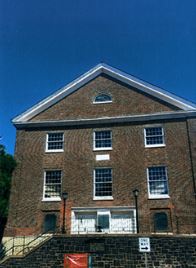Craig Jurgensen Books

Citizens of Brotherly LOVE
Published initially in 2018
The Yellow Fever epidemic of 1793, tragic and fatal as it was to thousands of residents of the crowded City of Philadelphia, was followed by a number of structural, social, and hygienic reforms which brought about many needed improvements in public health. Dr. Benjamin Rush, member of the Continental Congress and Signer of the Declaration of Independence, was the only fully trained physician to care for the sick and the dying at that difficult stage of American history. Absalom Jones, having recently sought freedom in Philadelphia from slavery in the South, was among a small band of African American men who volunteered to assist Dr. Rush in his toilsome duties. In the aftermath of that four- month epidemic, young Absalom became inspired to attend Benjamin Rush’s church – Christ Episcopal Church in Philadelphia. Recognizing the sacrificial effort that Absalom had demonstrated during the epidemic, Bishop William White decided to formally ordain him as an Episcopal priest in 1804. In doing so, Absalom Jones became the first Black priest of The Protestant Episcopal Church in America. Reverend Jones was instrumental in promoting a number of abolitionist and other social reforms and programs in the city, including the Free African Society, the Fugitive Slave Act, and the African Friendly Society of St. Thomas Church. His immortal Thanksgiving Day Sermon on January 1, 1808 coincided with the day that the United States Congress passed the law forbidding the importation of slaves. Together, Benjamin Rush and Absalom Jones worked as Citizens of Brotherly Love to make life healthy and livable for citizens in the City of Brotherly Love.
Published initially in 2018
20/tWeNTy, The Neurology of Blindness
Published initially in 2012

20/tWeNTy, The
Neurology of Blindness
You need more than basic 20/20 visual acuity on the E-chart in order to read and to benefit from this book titled 20/tWeNTy, The Neurology of Blindness. Light stimuli received by the human retina are relayed directly along axonal pathways into the central nervous system where complex neuronal networks bring to consciousness all objects of the visible world. Understanding the location and the function of these networks in the brain allow one to consider whether his visual symptoms may be of cerebral origin or not. Pathology arising in any one of these areas has the potential of causing confusing visual difficulties – referred to clinically by use of the term visual agnosia {Gr a-, not + gnosis, knowledge} > loss of the ability to identify objects, faces, and places. Anatomical pathology or damage to any one or another of these centers in the brain may cause, for example, a person to be unable to read text or to write a letter, to understand numbers or handle money, to walk safely in the neighborhood or how to cross the street safely, to find the kitchen in one’s own house, to select items for purchase in a store, or to select garments to wear and how to dress herself. The real-life example of such a person in this book was the wife of the author himself. Joan Jurgensen suffered initially with visual agnosia from the later effects of Alzheimer’s disease. Her husband, Craig, served as her primary care giver from the beginning unto the end. Anatomical illustrations of neural centers in the brain were artfully created by the author.
Published initially in 2018
20/tWeNTy, The Neurology of Blindness
Published initially in 2012

Rounds with Jim: A Medical Biography
I witnessed my church pastor suffer and die from Parkinson’s disease in 1964. I set my career plans at that point to become a physician and to practice neurology. Many years later, my friend and collegue developed Parkinson’s disease. I treated Jim professionally for ten years, and then continually – after retirement – as a friend and advocate.





Benjamin Rush (Craig Jurgensen) in support of Absalom Jones (Anthony C. Alexander
Craig Jurgensen, M.D. Craig Jurgensen began his writing career in 1958 when he edited his high school year book, titled the Pensman. He wrote thousands of medical biographies and scientific documents during a forty-year career as a practicing neurologist. He took up book writing after retirement in 2008, and so far, has written: Tempo di Marcia (history of Central Pennsylvania Youth Ballet); 20/twenty – the Neurology of Blindness; Rounds with Jim (A Biography of Parkinson’s disease); A Date to Marry; I’ll be Seeing You; and most recently Citizens of Brotherly Love (the story of Dr. Benjamin Rush in Philadelphia.) Craig was married a full lifetime to Joan “Joie” Jurgensen until her death in 2017. Craig and his wife, Joan, were married for 54 years and together raised three wonderful children – Heather, Susan, and John.

Craig Jurgensen
Author